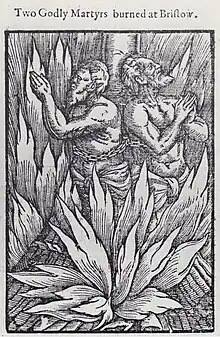Bewell's Cross
Bewell's Cross is a lost monument which marked the boundary of the county of Bristol when this was created in 1373.[1] The name goes back at least as far as 1188, however, when it is referred to in a charter of King John 'quandam crucem vocatam Bewellescross' (a certain cross called Bewell's Cross).[2] The 1373 survey mentions the Cross twice, noting that those perambulating the boundary should go up the highway to Henbury 'as far as a certain cross called Bewellescrosse, and from thence further northwards as far as a stone fixed hard by the spring of Bewelle.'.[3] It then goes on to say that the boundary returned back south along 'the same king’s highway as far as another stone fixed hard by the aforesaid cross on the eastern part of the same cross'.[4]



The cross stood in or close to the Gallows Field at the top of St Michael's Hill, the former principal road from Bristol to Wales via the Severn ferry at Aust. This is where the Bristol's 'Marian Martyrs' were burnt in 1556-7, events described in John Foxe's Book of Martyrs (1563).[5] The executions are memorialised in what is now Cotham Church.[6]
.png.webp)
A 1736 survey of the county boundaries suggests the cross was still extant, in that it mentions a boundary stone 'on the High Bank, over-against the Cross'.[7] However, the cross is not depicted on the 1743 map by John Rocque. Writing in 1789, the historian, William Barrett, noted that 'Bewell or Bewell's Cross then called is that where the criminals now usually pray before their execution at St. Michael's-hill gallows.' [8] Barrett's description of the site as being formerly known as Bewell's Cross, may suggest that the cross had been removed by then. A stone claimed to be taken from its pedestal is built into the wall of Cotham Church, marked by a plaque.
Bewell's Cross took its name from a spring a short way to the north-west whose name is likely to derive from the Old English for 'bee well'. But there was a Bristolian called Elias or Elys recorded in about 1270 with the surname Beowolf.[9] It is just possible that Beowolf is a punning alteration of the name of the spring, although Beowulf is known as a rare surname elsewhere.
Bewell's Cross may have been historically confused with Bewys Cross in Kingsweston, also now within the boundaries of the city of Bristol.
References
- Richard Coates, 'Two Bristol Crosses: Bewell’s Cross, St Michael on the Mount Without Parish, and Bewys Cross, Kingsweston', Transactions of the Bristol & Gloucestershire Archaeological Society 132 (2014), 217–222
- Coates, 'Two Bristol Crosses', p. 221.
- Norah Dermott Harding (ed.), Bristol Charters, 1155-1373 (Bristol Record Society publications, Vol. I, Bristol, 1930), p. 157.
- Norah Dermott Harding (ed.), Bristol Charters, 1155-1373 (Bristol Record Society publications, Vol. I, Bristol, 1930), p. 157.
- John Foxe, The acts and monuments of the church, containing the history and sufferings of the martyrs, ed. Michael Hobart Seymour (1855), p. 976
- K. G. Powell, The Marian Martyrs and the Reformation in Bristol (Bristol Historical Association, 1972), pp. 10, 17.
- Anon., Bristol. The City Charters...To which are added, The Bounds of the City, by Land, with the exact Distances from Stone to Stone, all round the City (Felix Farley, Bristol, 1736)
- William Barrett, The History and Antiquities of the City of Bristol (Bristol 1789), p. 665, note
- Coates, 'Two Bristol Crosses', p. 222.